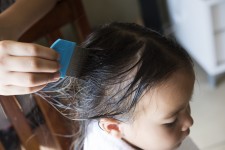Scientists acknowledged a few months ago that the United States was witnessing a lice resurgence, with a new strain of the irritating bug making the scene. And these critters have staying power, mainly, because they evolved by becoming immune to typical over-the-counter medicines commonly used over the last couple decades.
In light of this most recent outbreak and its continuance — which has affected at least 25 states — the first thing you need to know is this: Today's lice are not what they used to be, and if your child's head becomes the temporary home of an infestation, a much more vigorous approach, which includes prescription antidotes, will be needed to dispatch these unwelcome guests.
Secondly, if you think the case confronting you won't be the worst kind, think again. Data suggests that these pests, now being referred to as "super lice," are the cause of nearly 100 percent of all cases being reported.
Some background: Last August, Kyong Yoon, Ph.D, a researcher from Souther Illinois University, presented his findings at the National Meeting & Exposition of the American Chemical Society. He confirmed that lice populations in half of the U.S. — mainly in midwestern states, but not exclusively — have developed resistance to common treatments. These adaptive hair-dwellers, which are usually but not exclusively passed from one child to another in school, have undergone alterations of their genes.
“We are the first group to collect lice samples from a large number of populations across the U.S.,” Dr. Yoon told the ACS. “What we found was that 104 out of 109 lice populations we tested had high levels of gene mutations, which have been linked to resistance to pyrethroids.”
Pyrethroids are organic compounds that constitute insecticides. They are typically used to combat mosquitos and other insects, and they include a substance called permethrim. Permethrim is the active ingredient in some of the most commonly used lice treatments —treatments in these trouble spots that are proving to be less and less effective.
Dr. Yoon tested the lice for the genetic mutation "triad" known as “knock down resistance” or kdr, for short. Many of the lice did, in fact, exhibit all three kdr mutations, which affects the insects' nervous system.
An affected nervous system is what desensitizes them to pyrethroids.
California, Texas, Florida and Maine are states where lice seem to have all three mutations — making them the most resistant to typical over-the-counter (OTC) treatments.
Lice found in New York, New Jersey, New Mexico and Oregon were somewhat less resistant.
And fortunately for Michigan, lice found there showed no mutations and it was the only state where lice could still be defeated using OTC treatments. Researchers remain unclear as to why this might be.
In 2014, the University of Massachusetts, Amherst published a study that looked at lice between 2007 and 2009 from 32 sites in the U.S. and Canada. They found that 99.6 percent of those tested were genetically resistant to pyrethroids. But it wasn't until Dr. Yoon's discovery of the genetic mutation triad, and compromised nervous system as a result of our over-reliance on permethrin, did it become clear as to why these lice became resistant to typical OTC treatments.
This stronger strain of lice can still be eradicated by using applied treatments, but it's no longer as simple as getting them from your local drug store. These stronger chemicals are available by prescription only and include benzyl alcohol, ivermectin or malathion lotion.
Still, one should be cautious when using any chemical to treat them.
“If you use a chemical over and over, these little creatures will eventually develop resistance,” Dr. Yoon added. “So, we have to think before we use a treatment."
Super lice are not harmful, as they do not carry diseases. But they are terribly annoying, as any kid or parent will tell you. And when the Centers for Disease Control reports that an estimated 6-to-12 million lice infestations occur each year, it is no surprise how these little critters can become a big nuisance.



